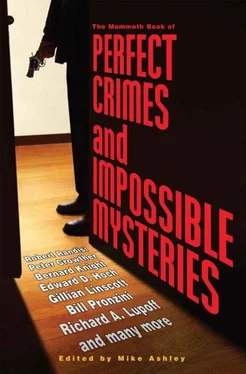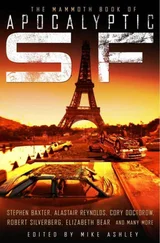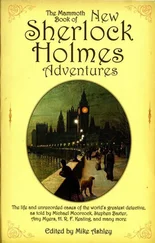He turned to the picture beside him and withdrew the nail, pulling himself up as if for a repugnant job. He walked over to the north window and motioned us to take our places on either side of him. Then he bent down and inserted the nail, point first, into the indentation in the plank, as firmly as he could. He braced himself and apparently strove to pull the nail toward the south, away from the window.
I was struggling with an obvious doubt. I said, “But you told us the planks could not be lifted.”
“Can’t,” Tarrant grunted. “But they can be slid. ”
Under his efforts the plank was, in fact, sliding. Its end appeared from under the footboard at the base of the north wall below the window and continued to move over a space of several feet. When this had been accomplished, he grasped the edges of the planks on both sides of the one already moved and slid them back also. An opening quite large enough to squeeze through was revealed.
But that was not all. The huddled body of a man lay just beneath; the man was clad only in underwear and was obviously dead from the beating in of his head.
As we bent over, gasping at the unexpectedly gory sight, Gleeb suddenly cried, “But that is not Michael Salti! What is this, a murder farm? I don’t know this man.”
Inspector Peake’s voice was ominous with anger. “I do. That is the body of Officer Weber. But how could he-”
Tarrant had straightened up and was regarding us with a look that said plainly he was anxious to get an unpleasant piece of work finished. “It was simple enough,” he ground out. “Salti cut out the planks beneath the bath-tub in the lavatory so that these planks in the studio could be slid back over the beam along the foundation under the south wall; their farther ends in this position will now be covering the hole in the lavatory floor. The floor here is well fitted and the planks are grooved, thus making the sliding possible. They can be moved back into their original position by someone in the space below here; doubtless we shall find a small block nailed to the under portion of all three planks for that purpose.
“He murdered his model, set the scene and started his phonograph, which will run interminably on the electric current. Then he crawled into his hiding-place. The discovery of the crime could not be put off any later than the chambermaid’s visit in the morning, and I have no doubt he took a sadistic pleasure in anticipating her hysterics when she entered. By chance your radio man, Gleeb, caused us to enter first.
“When the place was searched and the murderer not discovered, his pursuit passed elsewhere, while he himself lay concealed here all day. It was even better than doubling back upon his tracks, for he had never left the starting post. Eventually, of course, he had to get out, but by that time the vicinity of this building would be the last place in which he was being searched for.
“Early this morning he pushed back the planks from underneath and came forth. I don’t know whether he had expected anyone to be left on guard, but that helped rather than hindered him. Creeping up upon the unsuspecting guard, he knocked him out – doubtless with that mallet I can just see beside the body – and beat him to death. Then he put his second victim in the hiding-place, returning the instrument that closes it from above, the nail, to its position in the painting. He had already stripped off his own clothes, which you will find down in that hole, and in the officer’s uniform and coat he found no difficulty in leaving the building. His first action was to hurry to a lunch-room, naturally, since after a day and a night without food under the floor here, he must have been famished. I have no doubt that your men will get a report of him along Lexington Avenue, Peake; but, even so, he now has some hours’ start on you.”
“We’ll get him,” Peake assured us. “But if you knew all this, why in heaven’s name didn’t you have this place opened up last night, before he had any chance to commit a second murder? We should have taken him red-handed.”
“Yes, but I didn’t know it last night,” Tarrant reminded him. “It was not until late yesterday afternoon that I had any proper opportunity to examine the penthouse. What I found was a sealed room and a sealed house. There was no exit that had not been blocked nor, after our search, could I understand how the man could still be in the penthouse. On the other hand, I could not understand how it was possible that he had left. As a precaution, in case he were still here in some manner I had not fathomed, I urged you to leave at least two men on guard, and it was my understanding that you agreed. I think it is obvious, although I was unable then to justify myself, that the precaution was called for.”
Peake said, “It was.”
“I have been up all night working this out. What puzzled me completely was the absence of any trap doors. Certainly we looked for them thoroughly. But it was there right in front of us all the time; we even investigated a portion of it, the aperture in the lavatory floor, which we supposed to be a trap-door itself, although actually it was only a part of the real arrangement. As usual the trick was based upon taking advantage of habits of thought, of our habitised notion of a trap-door as something that is lifted or swung back. I have never heard before of a trap-door that slides back. Nevertheless, that was the simple answer, and it took me until five-thirty to reach it.”
Katoh, whom for the moment I had forgotten completely, stirred uneasily and spoke up. “I not see, Misster Tarrant, how you reach answer then.”
“Four things,” was the reply. “First of all, the logical assumption that, since there was no way out, the man was still here. As to the mechanism by which he managed to remain undiscovered, three things. We mentioned them last night. First, the nail hole in the plank; second, the position of the easel; third, the hole in the lavatory floor. I tried many ways to make them fit together, for I felt sure they must all fit.
“It was the position of the easel that finally gave me the truth. You remember we agreed that it was wrong, that the murderer had never intended to leave it facing away from the room. But if the murderer had left it as he intended, if no one had entered until we did, and still its position was wrong, what could have moved it in the meantime? Except for the phonograph, which could scarcely be responsible, the room held nothing but motionless objects. But if the floor under one of its legs had moved, the easel would have been slid around. That fitted with the other two items, the nail hole in the plank, the opening under the bath-tub.
“The moment it clicked, I got an automatic and ran up here. I was too late. As I said, I’ve been up all night. I’m tired; and I’m going to bed.”
He walked off without another word, scarcely with a parting nod. Tarrant, as know now, did not often fail. He was a man who offered few excuses for himself and he was humiliated.
It was a week or so later when I had an opportunity to ask him if Salti had been captured. I had seen nothing of it in the newspapers, and the case had now passed to the back pages with the usual celerity of sensations.
Tarrant said, “I don’t know.”
“But haven’t you followed it up with that man, Peake?”
“I’m not interested. It’s nothing but a straight police chase now. This part of it might make a good film for a Hollywood audience, but there isn’t the slightest intellectual interest left.”
He stopped and added after an appreciable pause, “Damn it, Jerry, I don’t like to think of it even now. I’ve blamed the stupidity of the police all I can; their throwing me out when I might have made a real investigation in the morning, that delay; their the negligence in overlooking my suggestion for a pair of guards, which I made as emphatic as I could. But it’s no use. I should have solved it in time, even so. There could only be that one answer and I took too long to find it.
Читать дальше











